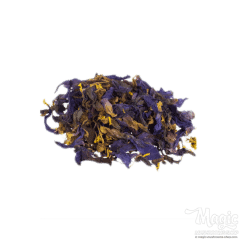All about the Blue Lotus Nelumbo nucifera flower
Posted under: How to's, Our products

Blue Lotus, also known as Nelumbo nucifera or blue lily, is a flower that has a rich history spanning thousands of years and across various cultures such as the Egyptian, Mayan, Syrian, and Thai. Its beauty, captivating fragrance, and intoxicating effects have made it highly revered and sought-after throughout history.
The ancient Egyptians, in particular, held the blue lotus in high esteem and used it as a "party drug" during secret temple gatherings of elite society. The blue lotus extract was mixed with sacred wines and consumed, leading to religiously charged orgies due to the flower's famed aphrodisiac properties. This use of the flower is evidenced in numerous murals, papyrus, and temples throughout Egypt, including the Turin Papyrus.

The flower's significance in Egyptian society went beyond its use as a party drug. Women on the streets wore blue lotus flowers in their hair or headdress as a fashion statement. The flower is even cited in the Egyptian Book of The Dead, one of the most important historical artifacts from the civilization. Ancient blue lotus flowers were also found scattered over Tutankhamun's body when he was un-casked in 1922.
The ancient Greeks also stumbled upon the blue lotus and exported it. It is even thought to be mentioned in Homer's Odyssey. Overall, the blue lotus has rightfully earned its place in history books as one of the most wonderful and significant flowers accessible to us.
The active alkaloids in Blue Lotus
Blue Lotus (Nelumbo nucifera) contains several alkaloids, including aporphine, nuciferine, and their derivatives.
Aporphine alkaloids are known for their psychoactive effects and are found in several plants, including the blue lotus.
Nuciferine is another alkaloid found in blue lotus, and it has been shown to have a wide range of pharmacological activities, including antioxidant, anti-inflammatory, and analgesic effects.
Additionally, other alkaloids such as roemerine, lotusine, and pronuciferine have been identified in blue lotus. These alkaloids are responsible for the flower's psychoactive and medicinal properties and have been the subject of various studies on their potential therapeutic benefits.
Popular use of Blue lotus
Blue Lotus (Nelumbo nucifera) has been traditionally used for various purposes, including medicinal, religious, and recreational. Here are some of the popular uses of blue lotus and how it is used:
- Relaxation and Mood Enhancement: Blue lotus has calming and sedative effects that can help to relieve anxiety, stress, and promote relaxation. It can also help to enhance mood and induce a feeling of euphoria. To achieve these effects, blue lotus is often consumed in the form of tea, tinctures, or smoked.
- Aphrodisiac: Blue lotus has been used as an aphrodisiac to enhance libido and sexual function. It is believed to increase blood flow to the genital area and stimulate sexual desire. To use blue lotus as an aphrodisiac, it can be consumed as tea or smoked.
- Meditation and Spiritual Practices: Blue lotus has been used in various spiritual practices and meditation to induce a trance-like state and enhance spiritual experiences. It is believed to facilitate communication with the divine and enhance intuition. Blue lotus can be consumed in the form of tea, tinctures, or smoked to achieve these effects.
- Pain Relief: Blue lotus has been used as a natural pain reliever due to its analgesic and anti-inflammatory properties. It can help to relieve headaches, menstrual cramps, and other types of pain. Blue lotus can be consumed as tea, tinctures, or smoked to achieve these effects.
- Skincare: Blue lotus has antioxidant and anti-inflammatory properties that can help to protect the skin from damage and reduce inflammation. It is also believed to have anti-aging properties and can help to improve skin tone and texture. Blue lotus can be applied topically in the form of creams, lotions, or facial masks.
How to prepare Blue lotus
Blue Lotus (Nelumbo nucifera) can be prepared in various ways, depending on the intended use. Here are three common ways to prepare blue lotus:
- Blue Lotus Tea: Blue lotus tea is one of the most popular ways to consume blue lotus. To prepare blue lotus tea, steep 1-2 teaspoons of dried blue lotus flowers or leaves in hot water for 5-10 minutes. Strain the tea and drink it while it's still warm.
- Blue Lotus Tincture: Blue lotus tincture is a concentrated extract of blue lotus that can be used for medicinal or recreational purposes. To make blue lotus tincture, soak dried blue lotus flowers or leaves in alcohol (such as vodka or rum) for several weeks. Strain the liquid and store it in a dark glass bottle. The tincture can be consumed by adding a few drops to a drink or taking it sublingually.
- Blue Lotus Smoking Blend: Blue lotus can also be smoked as a herbal smoking blend. To make a blue lotus smoking blend, mix dried blue lotus flowers with other herbs, such as damiana or mugwort. The blend can be smoked using a pipe or rolled into a cigarette. Smoking blue lotus can produce a mild psychoactive effect and promote relaxation. However, smoking any substance can have harmful effects on the lungs and overall health, so caution should be exercised when using this method of consumption.
How to grow your own Blue lotus
The stunning aquatic plant that can be grown in a home or garden setting. It's a relatively easy plant to care for, and its exotic appearance makes it a popular choice for water gardens and ornamental ponds. Here are some ways to grow blue lotus in your home or garden:
- Choosing the Right Container: The first step in growing blue lotus is to choose the right container. Blue lotus can be grown in a pond, water garden, or even in a container. If you're growing blue lotus in a container, choose a pot that's at least 12 inches in diameter and 8 inches deep. Make sure the pot has drainage holes at the bottom to prevent the roots from sitting in water.
- Planting Blue Lotus: Blue lotus should be planted in a mixture of loam soil and clay soil. Fill the container with the soil mixture, leaving a space of about 2 inches at the top. Gently place the blue lotus tubers on top of the soil, making sure that they're not buried too deep. Cover the tubers with a thin layer of soil and press down lightly to anchor them.
- Adding Water: After planting, slowly fill the container with water until it's about 6 inches deep. The water should cover the soil and tubers completely. Keep in mind that blue lotus needs at least 6 hours of sunlight per day, so place the container in a sunny location.
- Fertilizing Blue Lotus: Blue lotus should be fertilized every 2-3 weeks during the growing season. You can use a slow-release fertilizer or a liquid fertilizer that's specifically formulated for aquatic plants. Be sure to follow the manufacturer's instructions carefully, as over-fertilization can damage the plant.
- Maintaining Water Quality: It's important to maintain the water quality in your blue lotus container. Change the water once a week, removing any debris or dead leaves that may have accumulated. If you notice that the water is becoming murky or foul-smelling, it may be a sign of poor water quality. In this case, consider adding an aquatic plant filter to help maintain water quality.
- Winter Care: Blue lotus is a tropical plant and cannot survive in freezing temperatures. If you live in an area with cold winters, you'll need to bring your blue lotus inside for the winter. Before bringing it inside, trim off any dead leaves and remove the plant from the container. Store the tubers in a cool, dry place until the next growing season.
Blue Lotus is a fascinating flower with a rich history and various uses. Whether you're seeking relaxation, spiritual experiences, pain relief, or skincare benefits, Blue Lotus can be prepared in different ways to suit your needs.


November 27, 2022